Église Sainte-Marthe de Tarascon or Collégiale Royale Sainte-Marthe is a collegiate church in Tarascon, France, dedicated to Saint Martha. It is where, according to a local tradition, the biblical figure Martha is buried.
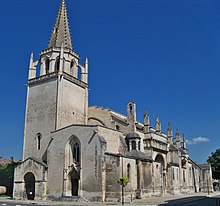
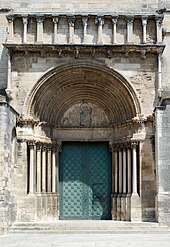
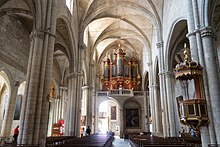
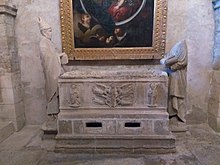
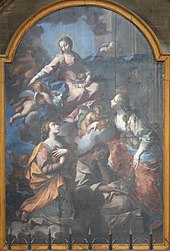
History
editCollegiate Sainte-Marthe was dedicated in 1197 and enlarged in the 14th and 15th centuries. It was built half-Romanesque in the 12th century and half-Gothic in the 14th century.
The tympanum and lintel of the Romanesque southern portal were severely damaged during the French Revolution.
The tip of the church tower was destroyed during Allied bombings on August 16, 1944. It was later rebuilt.
Features
editThe crypt dates from the 3rd century. It houses the relics of Martha in a sarcophagus of the 4th century.
Church paintings include:
Painting by Charles-André van Loo:
- Mort de Saint François or Saint François d'Assise recevant les stigmates (1730)
- Sainte Marthe domptant la Tarasque (1730). Originally in the convent of the Capuchins and later in Eglise Saint-Jacques.
Paintings by Joseph-Marie Vien. Based on the narrative of the Golden Legend, they were initially part of a series painted for the convent of the Capuchins in Tarascon.[1][2]
- Sainte Marthe recevant le Christ à Bethanie (1747)[3]
- La résurrection de Lazare (1747)[4]
- L'embarquement de sainte Marthe (1751)[5]
- L'arrivée de sainte Marthe en Provence (1748)[6]
- La prédication de sainte Marthe (1748)[7]
- L'agonie de sainte Marthe (1748)[8]
- Les funérailles de sainte Marthe (1748)[9]
Paintings by Nicolas Mignard:
Paintings by Pierre Parrocel:
- Sainte Cunégonde et sainte Cécile[12]
- Sainte Marie l'égyptienne[13]
- Le Christ sur la croix[14]
- Sainte Catherine de Sienne[15]
- Saint Thomas d'Aquin[15]
- Adoration des Mages[16]
- Adoration des Bergers[17]
- L'Annonciation[18]
- Notre Dame du peuple[19]
Painting by Philippe Sauvan:
- Saint Dominique (1789) [20]
References
edit- ^ Chaussard, Pierre Jean-Baptiste (1806). Le Pausanias français: état des arts du dessin en France, à l'ouverture du XIXe siecle: Salon de 1806. Paris: F. Buisson. p. 47.
- ^ Gaehtgens, Thomas W.; Lugand, Jacques (1988). Joseph-Marie Vien, peintre du roi, 1716-1809. Arthena. pp. 17, 61, 136. ISBN 9782903239091.
- ^ Base Palissy: Tableau: Sainte Marthe recevant le Christ à Bethanie
- ^ Base Palissy: Tableau: La résurrection de Lazare
- ^ Base Palissy: Tableau: L'embarquement de sainte Marthe
- ^ Base Palissy: Tableau: L'arrivée de sainte Marthe en Provence
- ^ Base Palissy: Tableau: La prédication de sainte Marthe
- ^ Base Palissy: Tableau: L'agonie de sainte Marthe
- ^ Base Palissy: Tableau: Les funérailles de sainte Marthe
- ^ Base Palissy: Tableau: L'Assomption
- ^ Base Palissy: Tableau: Arrivée du Christ en Béthanie
- ^ Base Palissy: Tableau: Sainte Cunégonde et sainte Cécile
- ^ Base Palissy: Tableau: Sainte Marie l'Égyptienne
- ^ Base Palissy: Tableau: Le Christ en croix
- ^ a b Base Palissy: 2 tableaux : Saint Thomas d'Aquin, Sainte Catherine de Sienne
- ^ Base Palissy: Tableau: Adoration des mages
- ^ Base Palissy: Tableau: Adoration des bergers
- ^ Base Palissy: Tableau: L'Annonciation
- ^ Base Palissy: Tableau: Notre Dame du peuple
- ^ Base Palissy: Tableau: Saint Dominique
Further reading
edit- Faillon, Étienne-Michel (1835). Monumens de l'église de Sainte-Marthe à Tarascon, département des Bouches-du-Rhône (in French). Tarascon: Élisée Aubanel, Imprimeur-libraire.
External links
edit- Church of Saint Martha Archived 2009-05-29 at the Wayback Machine, Tarascon Monuments and Museums, Official website of Tarascon's tourist office.
- Collégiale Sainte-Marthe / Tarascon
- Collégiale Sainte Marthe
- Entry at pays-arles.org (in French)